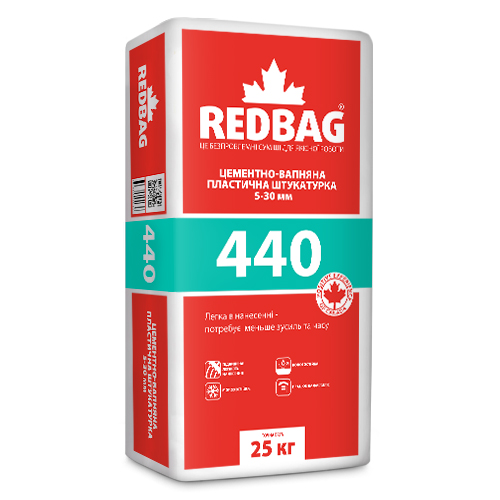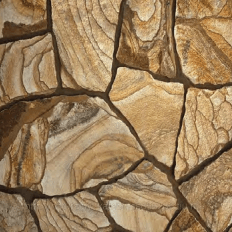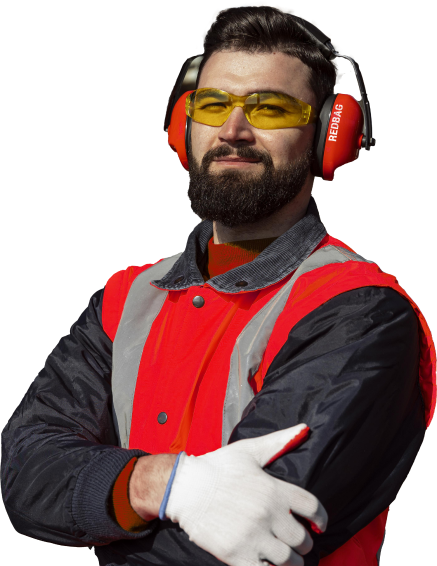REDBAG 440 is a mixture intended for plastering manually or mechanically (using mortar mixing devices) all types of mineral bases. For interior and exterior work. Maximum filler fraction size: 1 mm.

REDBAG 440 CEMENT-LIME PLASTIC PLASTER 5-30 mm
Easy to apply – requires less effort and time.

-
Appointment
-
Preparing the base
The base must be dry, not frozen, strong, capable of bearing loads, cleaned of dust, dirt, oils, fats, greases, remnants of old paint, wax and other substances that reduce adhesion, have uniform water absorption, and meet the requirements of DSTU-N B A.3.1-23:2013, DSTU-N B V.2.6-212:2016. Remove weak areas of the base.
Ceramic brick walls and walls that are already finished with cement plasters have high moisture absorption, therefore, after cleaning, before plastering, they must be treated with REDBAG ADHESIS deep penetration primer.
Attention! Do not apply REDBAG 440 plaster to walls with a gypsum base.
Cast concrete walls have a smooth surface and low moisture absorption, so after cleaning before plastering, they must be treated with an adhesive primer for dense, smooth, low- or no-moisture-absorbing substrates - REDBAG SUPERSTICK. Smooth silicate brick walls must also be treated with an adhesive primer REDBAG SUPERSTICK before plastering.
-
Cooking method
Pour the REDBAG 440 dry mixture into a container with clean water (at the rate of 4.5-5 l of water per 25 kg or 180-200 ml per 1 kg of dry mixture), mix using a construction mixer until a homogeneous mass without lumps is formed. Leave for 3 minutes and mix again.
Preparation of the mortar mixture for application by machine. Prepare the plastering station for work. Set the required water flow rate on the plastering station water dispenser. Feed the mortar mixture to the work site using the plastering station.
Do not add other materials to the prepared adhesive solution.
Attention! REDBAG mixtures are created on the basis of modern high-tech recipes using the latest additives from world manufacturers.
When preparing the mixture, use water only in the amount indicated on the package!
-
Work execution technology
Work should be carried out at a base temperature of +5 °C to +30 °C.
Manual application. The mortar mixture is applied to the prepared surface using a ladle, spatula and leveled using a rule or a half-trowel. After partial hardening, smooth with a plastering trowel.
Machine application. With a mechanized method of work, any plastering station can be used to apply plaster. Plastering walls with a nozzle is usually carried out from left to right and from top to bottom, holding the spray gun perpendicular to the surface at a distance of 10-30 cm and forming grooves about 100 cm wide. The thickness of the plaster layer is regulated by the speed of movement of the gun. The work is carried out in such a way that the trace of the plaster spray moves along the lower edge of the strip of already applied mortar, the “caterpillar” method. Each subsequent application is applied with an overlap of 2-3 cm over the previous one.
During breaks in work for more than 30 minutes and after finishing work, the tool must be cleaned and rinsed with water.
The recommended thickness of one layer of plaster is from 5 to 30 mm. Surfaces with differences in the plane of more than 30 mm should be leveled in several layers, while the next layer should be applied immediately after the previous one has hardened (approximately after 2-3 hours, depending on the water absorption of the surface). When applying several layers, do not level the previous layer. If there are no beacons, check the horizontal and vertical deviations of the surface using a level, cord or rule. 24 hours after the installation of the main layer, dismantle the beacons, if any, and fill the dismantled places with the same mortar mixture and level them.
During work, the surface must not be allowed to dry out (do not use dehumidifiers and do not allow drafts), otherwise the walls will crack. Moisten the plastered surface within 48 hours after completion of work. You can putty or tile it after 48 hours.
-
Mixture consumption
1.4 kg per 1 m² with a layer thickness of 1 mm.
*The consumption of the mixture depends on the unevenness of the base and the skills of the performer.
REDBAG 440 mixture complies with: EN 998-1 GP CS-III and TsV.1.ShT2 DSTU B V.2.7-126:2011
Shelf life and storage conditions: 12 months from the date of manufacture, in a dry place, in undamaged original packaging. The date of manufacture is indicated on the packaging.







